The Imperative to Reduce Antibiotic Use in Food Production Systems
VerifiedAdded on 2023/01/18
|9
|1907
|45
Report
AI Summary
This report addresses the critical issue of antibiotic resistance stemming from antibiotic use in food animal production. It highlights the natural development of antibiotic resistance through random mutation and natural selection and emphasizes the importance of using antibiotics appropriately in both animal agriculture and human populations. The report details how antibiotics, used since the 1940s in farms to treat infections and promote growth, have contributed to increased resistance. It stresses the need for careful treatment protocols and withdrawal periods to prevent contamination of animal products with antibiotic residues. The report also discusses the role of intensive production systems in increasing resistance and the dissemination of antibiotic-resistant bacteria through the food chain, direct contact, and waste. Furthermore, it mentions international efforts, such as the ICMAR conference in Dubai, to address antimicrobial resistance. The report concludes by advocating for herd management, organic livestock production, and proper composting processes to minimize antibiotic residue discharge, alongside promoting alternatives to reduce antibiotic use and improve livestock health.
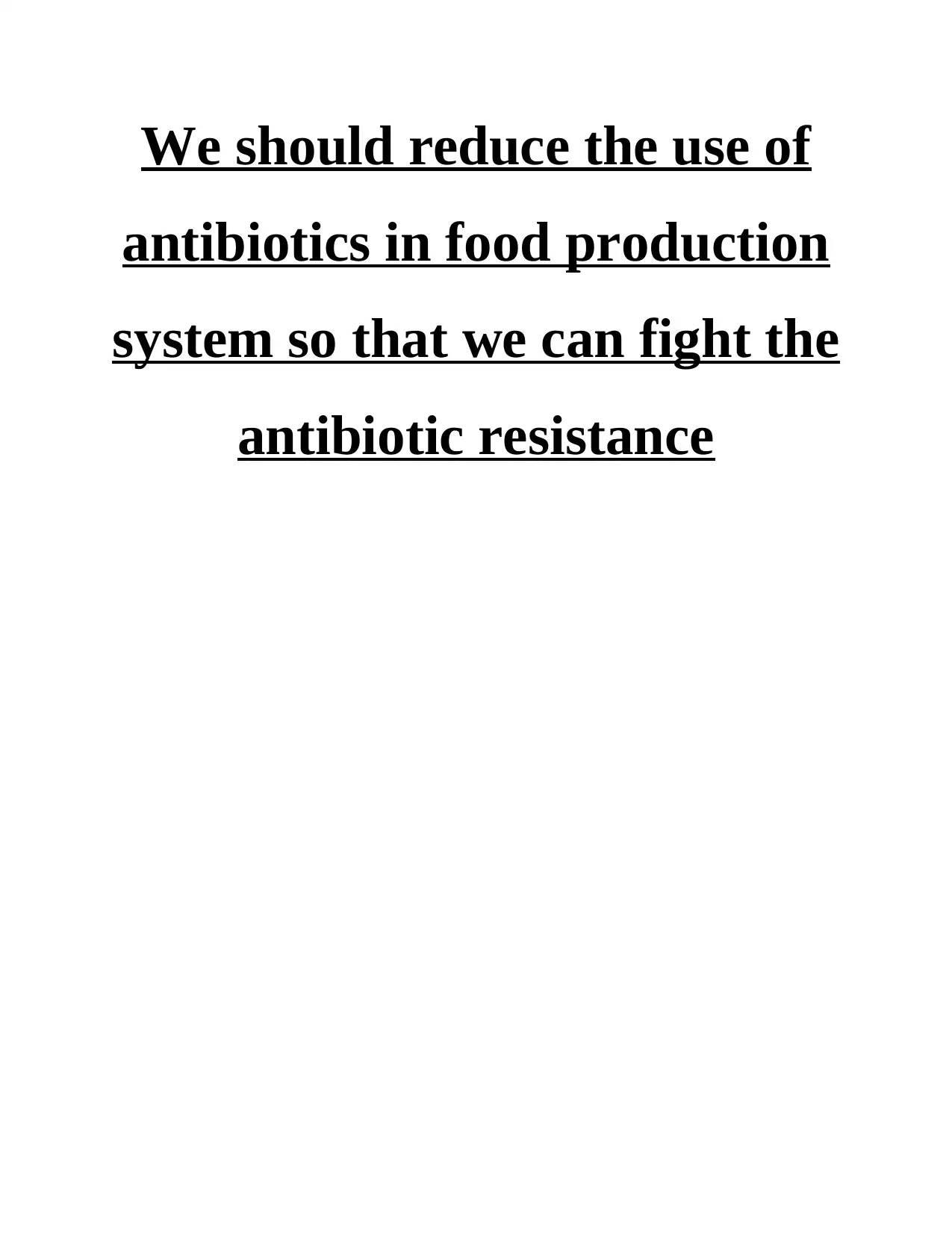
We should reduce the use of
antibiotics in food production
system so that we can fight the
antibiotic resistance
antibiotics in food production
system so that we can fight the
antibiotic resistance
Paraphrase This Document
Need a fresh take? Get an instant paraphrase of this document with our AI Paraphraser

Contents
INTRODUCTION...........................................................................................................................3
MAIN BODY..................................................................................................................................3
CONCLUSION................................................................................................................................6
REFERENCES................................................................................................................................6
INTRODUCTION...........................................................................................................................3
MAIN BODY..................................................................................................................................3
CONCLUSION................................................................................................................................6
REFERENCES................................................................................................................................6
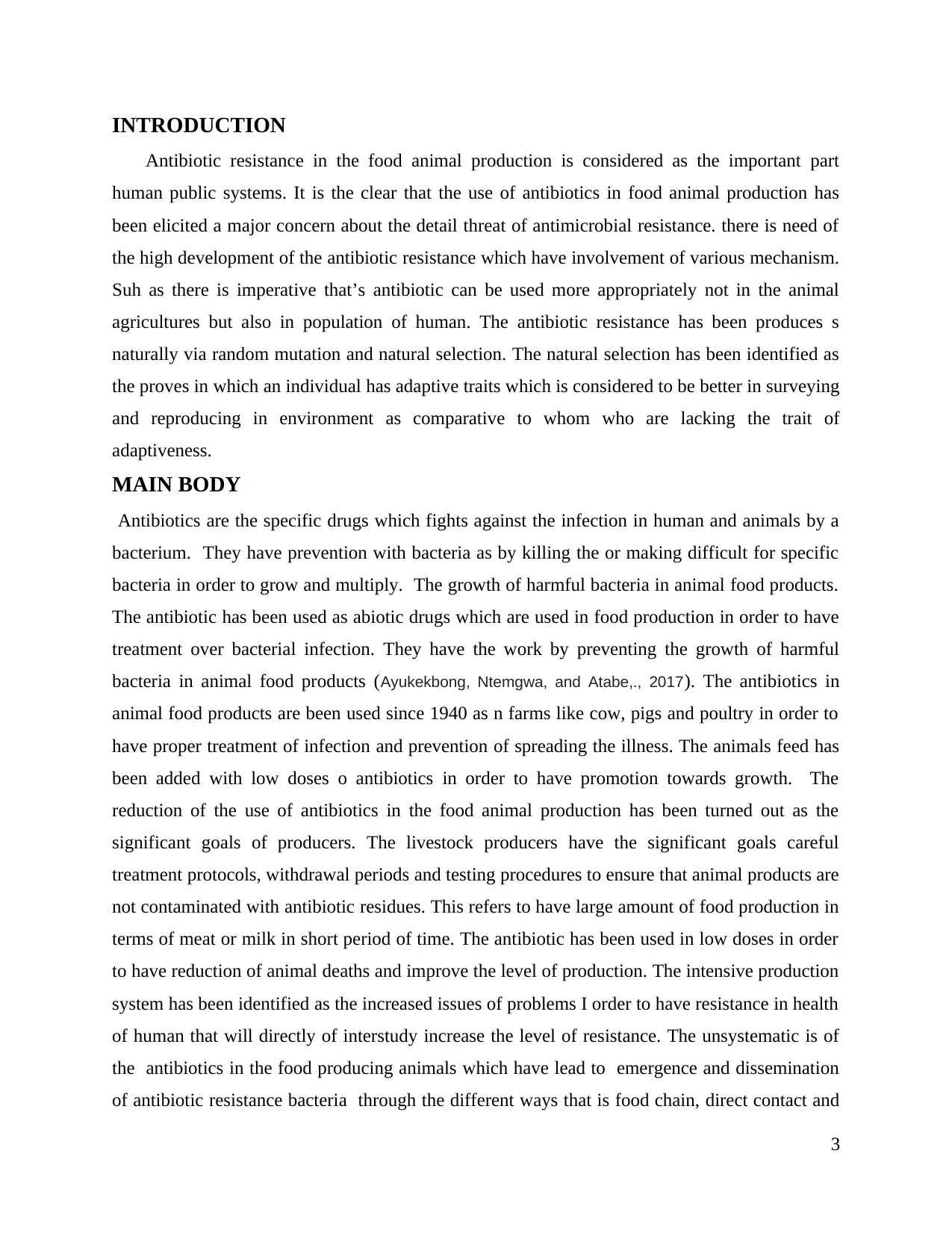
INTRODUCTION
Antibiotic resistance in the food animal production is considered as the important part
human public systems. It is the clear that the use of antibiotics in food animal production has
been elicited a major concern about the detail threat of antimicrobial resistance. there is need of
the high development of the antibiotic resistance which have involvement of various mechanism.
Suh as there is imperative that’s antibiotic can be used more appropriately not in the animal
agricultures but also in population of human. The antibiotic resistance has been produces s
naturally via random mutation and natural selection. The natural selection has been identified as
the proves in which an individual has adaptive traits which is considered to be better in surveying
and reproducing in environment as comparative to whom who are lacking the trait of
adaptiveness.
MAIN BODY
Antibiotics are the specific drugs which fights against the infection in human and animals by a
bacterium. They have prevention with bacteria as by killing the or making difficult for specific
bacteria in order to grow and multiply. The growth of harmful bacteria in animal food products.
The antibiotic has been used as abiotic drugs which are used in food production in order to have
treatment over bacterial infection. They have the work by preventing the growth of harmful
bacteria in animal food products (Ayukekbong, Ntemgwa, and Atabe,., 2017). The antibiotics in
animal food products are been used since 1940 as n farms like cow, pigs and poultry in order to
have proper treatment of infection and prevention of spreading the illness. The animals feed has
been added with low doses o antibiotics in order to have promotion towards growth. The
reduction of the use of antibiotics in the food animal production has been turned out as the
significant goals of producers. The livestock producers have the significant goals careful
treatment protocols, withdrawal periods and testing procedures to ensure that animal products are
not contaminated with antibiotic residues. This refers to have large amount of food production in
terms of meat or milk in short period of time. The antibiotic has been used in low doses in order
to have reduction of animal deaths and improve the level of production. The intensive production
system has been identified as the increased issues of problems I order to have resistance in health
of human that will directly of interstudy increase the level of resistance. The unsystematic is of
the antibiotics in the food producing animals which have lead to emergence and dissemination
of antibiotic resistance bacteria through the different ways that is food chain, direct contact and
3
Antibiotic resistance in the food animal production is considered as the important part
human public systems. It is the clear that the use of antibiotics in food animal production has
been elicited a major concern about the detail threat of antimicrobial resistance. there is need of
the high development of the antibiotic resistance which have involvement of various mechanism.
Suh as there is imperative that’s antibiotic can be used more appropriately not in the animal
agricultures but also in population of human. The antibiotic resistance has been produces s
naturally via random mutation and natural selection. The natural selection has been identified as
the proves in which an individual has adaptive traits which is considered to be better in surveying
and reproducing in environment as comparative to whom who are lacking the trait of
adaptiveness.
MAIN BODY
Antibiotics are the specific drugs which fights against the infection in human and animals by a
bacterium. They have prevention with bacteria as by killing the or making difficult for specific
bacteria in order to grow and multiply. The growth of harmful bacteria in animal food products.
The antibiotic has been used as abiotic drugs which are used in food production in order to have
treatment over bacterial infection. They have the work by preventing the growth of harmful
bacteria in animal food products (Ayukekbong, Ntemgwa, and Atabe,., 2017). The antibiotics in
animal food products are been used since 1940 as n farms like cow, pigs and poultry in order to
have proper treatment of infection and prevention of spreading the illness. The animals feed has
been added with low doses o antibiotics in order to have promotion towards growth. The
reduction of the use of antibiotics in the food animal production has been turned out as the
significant goals of producers. The livestock producers have the significant goals careful
treatment protocols, withdrawal periods and testing procedures to ensure that animal products are
not contaminated with antibiotic residues. This refers to have large amount of food production in
terms of meat or milk in short period of time. The antibiotic has been used in low doses in order
to have reduction of animal deaths and improve the level of production. The intensive production
system has been identified as the increased issues of problems I order to have resistance in health
of human that will directly of interstudy increase the level of resistance. The unsystematic is of
the antibiotics in the food producing animals which have lead to emergence and dissemination
of antibiotic resistance bacteria through the different ways that is food chain, direct contact and
3
⊘ This is a preview!⊘
Do you want full access?
Subscribe today to unlock all pages.

Trusted by 1+ million students worldwide
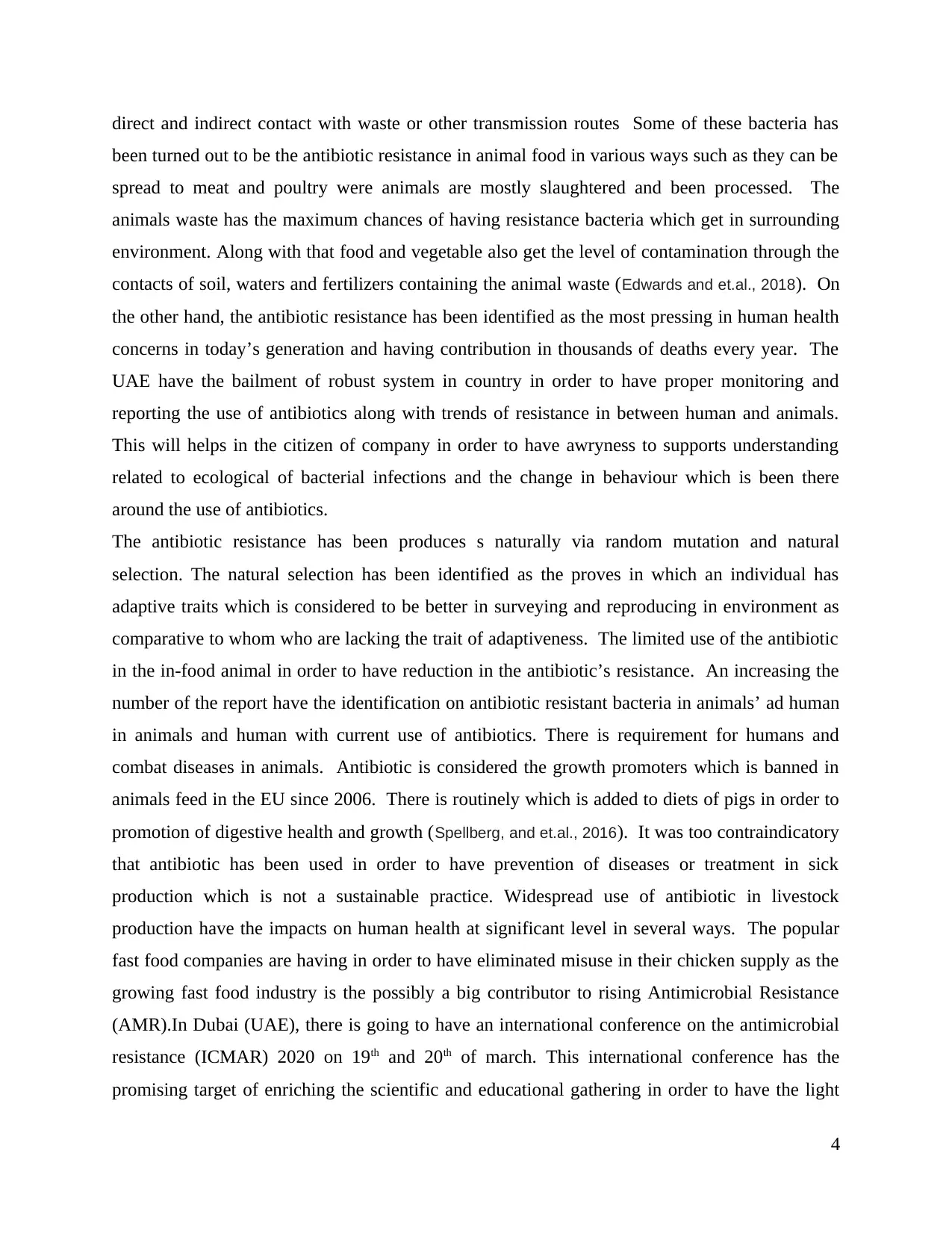
direct and indirect contact with waste or other transmission routes Some of these bacteria has
been turned out to be the antibiotic resistance in animal food in various ways such as they can be
spread to meat and poultry were animals are mostly slaughtered and been processed. The
animals waste has the maximum chances of having resistance bacteria which get in surrounding
environment. Along with that food and vegetable also get the level of contamination through the
contacts of soil, waters and fertilizers containing the animal waste (Edwards and et.al., 2018). On
the other hand, the antibiotic resistance has been identified as the most pressing in human health
concerns in today’s generation and having contribution in thousands of deaths every year. The
UAE have the bailment of robust system in country in order to have proper monitoring and
reporting the use of antibiotics along with trends of resistance in between human and animals.
This will helps in the citizen of company in order to have awryness to supports understanding
related to ecological of bacterial infections and the change in behaviour which is been there
around the use of antibiotics.
The antibiotic resistance has been produces s naturally via random mutation and natural
selection. The natural selection has been identified as the proves in which an individual has
adaptive traits which is considered to be better in surveying and reproducing in environment as
comparative to whom who are lacking the trait of adaptiveness. The limited use of the antibiotic
in the in-food animal in order to have reduction in the antibiotic’s resistance. An increasing the
number of the report have the identification on antibiotic resistant bacteria in animals’ ad human
in animals and human with current use of antibiotics. There is requirement for humans and
combat diseases in animals. Antibiotic is considered the growth promoters which is banned in
animals feed in the EU since 2006. There is routinely which is added to diets of pigs in order to
promotion of digestive health and growth (Spellberg, and et.al., 2016). It was too contraindicatory
that antibiotic has been used in order to have prevention of diseases or treatment in sick
production which is not a sustainable practice. Widespread use of antibiotic in livestock
production have the impacts on human health at significant level in several ways. The popular
fast food companies are having in order to have eliminated misuse in their chicken supply as the
growing fast food industry is the possibly a big contributor to rising Antimicrobial Resistance
(AMR).In Dubai (UAE), there is going to have an international conference on the antimicrobial
resistance (ICMAR) 2020 on 19th and 20th of march. This international conference has the
promising target of enriching the scientific and educational gathering in order to have the light
4
been turned out to be the antibiotic resistance in animal food in various ways such as they can be
spread to meat and poultry were animals are mostly slaughtered and been processed. The
animals waste has the maximum chances of having resistance bacteria which get in surrounding
environment. Along with that food and vegetable also get the level of contamination through the
contacts of soil, waters and fertilizers containing the animal waste (Edwards and et.al., 2018). On
the other hand, the antibiotic resistance has been identified as the most pressing in human health
concerns in today’s generation and having contribution in thousands of deaths every year. The
UAE have the bailment of robust system in country in order to have proper monitoring and
reporting the use of antibiotics along with trends of resistance in between human and animals.
This will helps in the citizen of company in order to have awryness to supports understanding
related to ecological of bacterial infections and the change in behaviour which is been there
around the use of antibiotics.
The antibiotic resistance has been produces s naturally via random mutation and natural
selection. The natural selection has been identified as the proves in which an individual has
adaptive traits which is considered to be better in surveying and reproducing in environment as
comparative to whom who are lacking the trait of adaptiveness. The limited use of the antibiotic
in the in-food animal in order to have reduction in the antibiotic’s resistance. An increasing the
number of the report have the identification on antibiotic resistant bacteria in animals’ ad human
in animals and human with current use of antibiotics. There is requirement for humans and
combat diseases in animals. Antibiotic is considered the growth promoters which is banned in
animals feed in the EU since 2006. There is routinely which is added to diets of pigs in order to
promotion of digestive health and growth (Spellberg, and et.al., 2016). It was too contraindicatory
that antibiotic has been used in order to have prevention of diseases or treatment in sick
production which is not a sustainable practice. Widespread use of antibiotic in livestock
production have the impacts on human health at significant level in several ways. The popular
fast food companies are having in order to have eliminated misuse in their chicken supply as the
growing fast food industry is the possibly a big contributor to rising Antimicrobial Resistance
(AMR).In Dubai (UAE), there is going to have an international conference on the antimicrobial
resistance (ICMAR) 2020 on 19th and 20th of march. This international conference has the
promising target of enriching the scientific and educational gathering in order to have the light
4
Paraphrase This Document
Need a fresh take? Get an instant paraphrase of this document with our AI Paraphraser
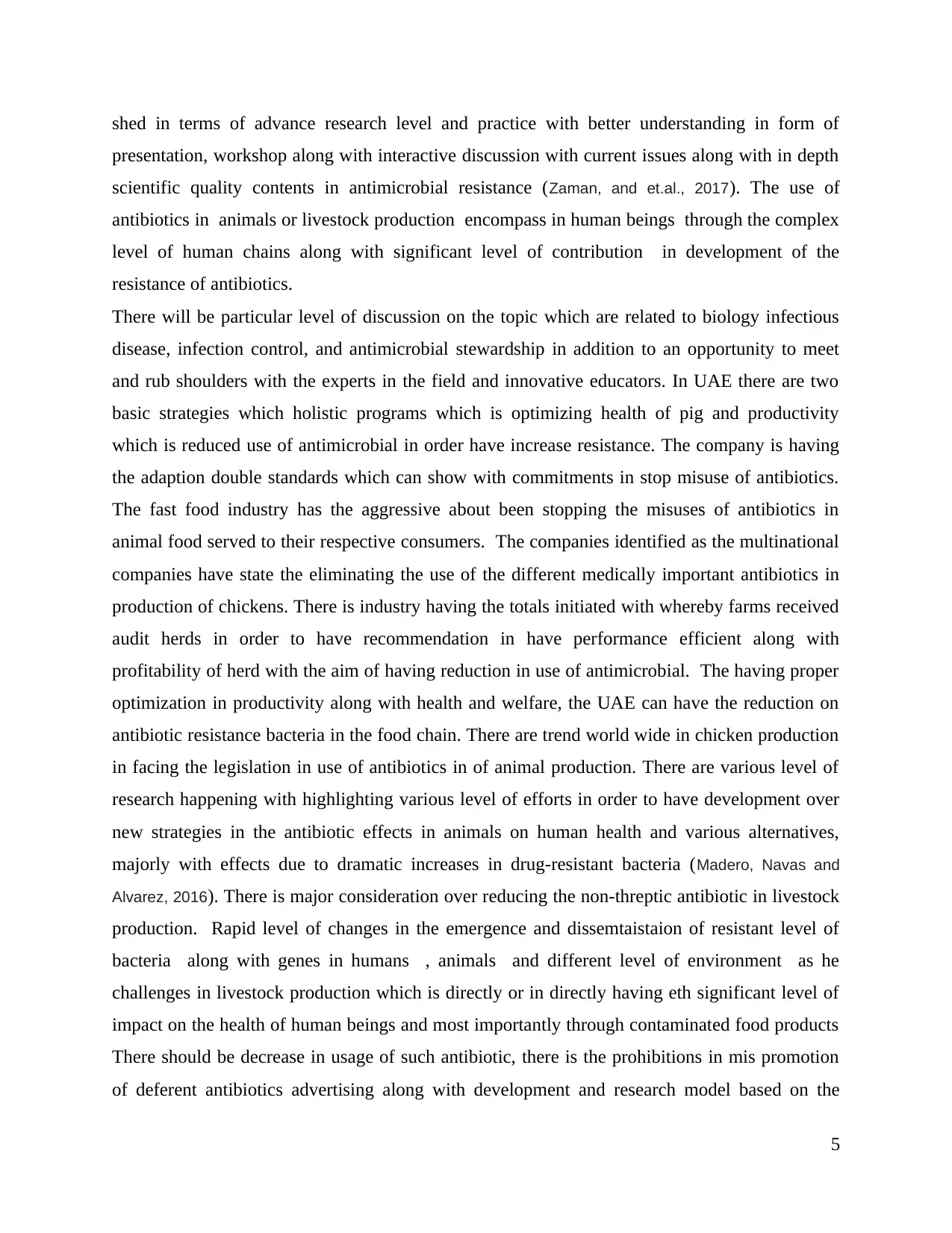
shed in terms of advance research level and practice with better understanding in form of
presentation, workshop along with interactive discussion with current issues along with in depth
scientific quality contents in antimicrobial resistance (Zaman, and et.al., 2017). The use of
antibiotics in animals or livestock production encompass in human beings through the complex
level of human chains along with significant level of contribution in development of the
resistance of antibiotics.
There will be particular level of discussion on the topic which are related to biology infectious
disease, infection control, and antimicrobial stewardship in addition to an opportunity to meet
and rub shoulders with the experts in the field and innovative educators. In UAE there are two
basic strategies which holistic programs which is optimizing health of pig and productivity
which is reduced use of antimicrobial in order have increase resistance. The company is having
the adaption double standards which can show with commitments in stop misuse of antibiotics.
The fast food industry has the aggressive about been stopping the misuses of antibiotics in
animal food served to their respective consumers. The companies identified as the multinational
companies have state the eliminating the use of the different medically important antibiotics in
production of chickens. There is industry having the totals initiated with whereby farms received
audit herds in order to have recommendation in have performance efficient along with
profitability of herd with the aim of having reduction in use of antimicrobial. The having proper
optimization in productivity along with health and welfare, the UAE can have the reduction on
antibiotic resistance bacteria in the food chain. There are trend world wide in chicken production
in facing the legislation in use of antibiotics in of animal production. There are various level of
research happening with highlighting various level of efforts in order to have development over
new strategies in the antibiotic effects in animals on human health and various alternatives,
majorly with effects due to dramatic increases in drug-resistant bacteria (Madero, Navas and
Alvarez, 2016). There is major consideration over reducing the non-threptic antibiotic in livestock
production. Rapid level of changes in the emergence and dissemtaistaion of resistant level of
bacteria along with genes in humans , animals and different level of environment as he
challenges in livestock production which is directly or in directly having eth significant level of
impact on the health of human beings and most importantly through contaminated food products
There should be decrease in usage of such antibiotic, there is the prohibitions in mis promotion
of deferent antibiotics advertising along with development and research model based on the
5
presentation, workshop along with interactive discussion with current issues along with in depth
scientific quality contents in antimicrobial resistance (Zaman, and et.al., 2017). The use of
antibiotics in animals or livestock production encompass in human beings through the complex
level of human chains along with significant level of contribution in development of the
resistance of antibiotics.
There will be particular level of discussion on the topic which are related to biology infectious
disease, infection control, and antimicrobial stewardship in addition to an opportunity to meet
and rub shoulders with the experts in the field and innovative educators. In UAE there are two
basic strategies which holistic programs which is optimizing health of pig and productivity
which is reduced use of antimicrobial in order have increase resistance. The company is having
the adaption double standards which can show with commitments in stop misuse of antibiotics.
The fast food industry has the aggressive about been stopping the misuses of antibiotics in
animal food served to their respective consumers. The companies identified as the multinational
companies have state the eliminating the use of the different medically important antibiotics in
production of chickens. There is industry having the totals initiated with whereby farms received
audit herds in order to have recommendation in have performance efficient along with
profitability of herd with the aim of having reduction in use of antimicrobial. The having proper
optimization in productivity along with health and welfare, the UAE can have the reduction on
antibiotic resistance bacteria in the food chain. There are trend world wide in chicken production
in facing the legislation in use of antibiotics in of animal production. There are various level of
research happening with highlighting various level of efforts in order to have development over
new strategies in the antibiotic effects in animals on human health and various alternatives,
majorly with effects due to dramatic increases in drug-resistant bacteria (Madero, Navas and
Alvarez, 2016). There is major consideration over reducing the non-threptic antibiotic in livestock
production. Rapid level of changes in the emergence and dissemtaistaion of resistant level of
bacteria along with genes in humans , animals and different level of environment as he
challenges in livestock production which is directly or in directly having eth significant level of
impact on the health of human beings and most importantly through contaminated food products
There should be decrease in usage of such antibiotic, there is the prohibitions in mis promotion
of deferent antibiotics advertising along with development and research model based on the
5

principle of relinkage. The UAE have the bailment of robust system in country in order to have
proper monitoring and reporting the use of antibiotics along with trends of resistance in between
human and animals. This will help in the citizen of company in order to have awryness to
supports understanding related to ecological of bacterial infections and the change in behaviour
which is been there around the use of antibiotics.
CONCLUSION
From the above report it can be concluded that the use of antibiotics in animals or livestock
production encompass in human beings through the complex level of human chains along with
significant level of contribution in development of the resistance of antibiotics (Dar and et.al.,
2016). There should be proper management along with herd management, organic livestock
production adoption and having the adequate level of livestock manure composting processes in
order to have the minimization of an effective strategy to minimize the discharge of antibiotic
residue into the environment. There can be between se of various alternatives in order to have the
promotion in minimizing the low usage of antibiotics in order to have proper improvement of
health’s status with the increased level of immunity of livestock. This struct adherence will help
in having proper control over labelling proper recommendation and consumer level of awryness
which is eventually helps in encompassing the emerging level of problems associated with
antibiotics resistance.
6
proper monitoring and reporting the use of antibiotics along with trends of resistance in between
human and animals. This will help in the citizen of company in order to have awryness to
supports understanding related to ecological of bacterial infections and the change in behaviour
which is been there around the use of antibiotics.
CONCLUSION
From the above report it can be concluded that the use of antibiotics in animals or livestock
production encompass in human beings through the complex level of human chains along with
significant level of contribution in development of the resistance of antibiotics (Dar and et.al.,
2016). There should be proper management along with herd management, organic livestock
production adoption and having the adequate level of livestock manure composting processes in
order to have the minimization of an effective strategy to minimize the discharge of antibiotic
residue into the environment. There can be between se of various alternatives in order to have the
promotion in minimizing the low usage of antibiotics in order to have proper improvement of
health’s status with the increased level of immunity of livestock. This struct adherence will help
in having proper control over labelling proper recommendation and consumer level of awryness
which is eventually helps in encompassing the emerging level of problems associated with
antibiotics resistance.
6
⊘ This is a preview!⊘
Do you want full access?
Subscribe today to unlock all pages.

Trusted by 1+ million students worldwide
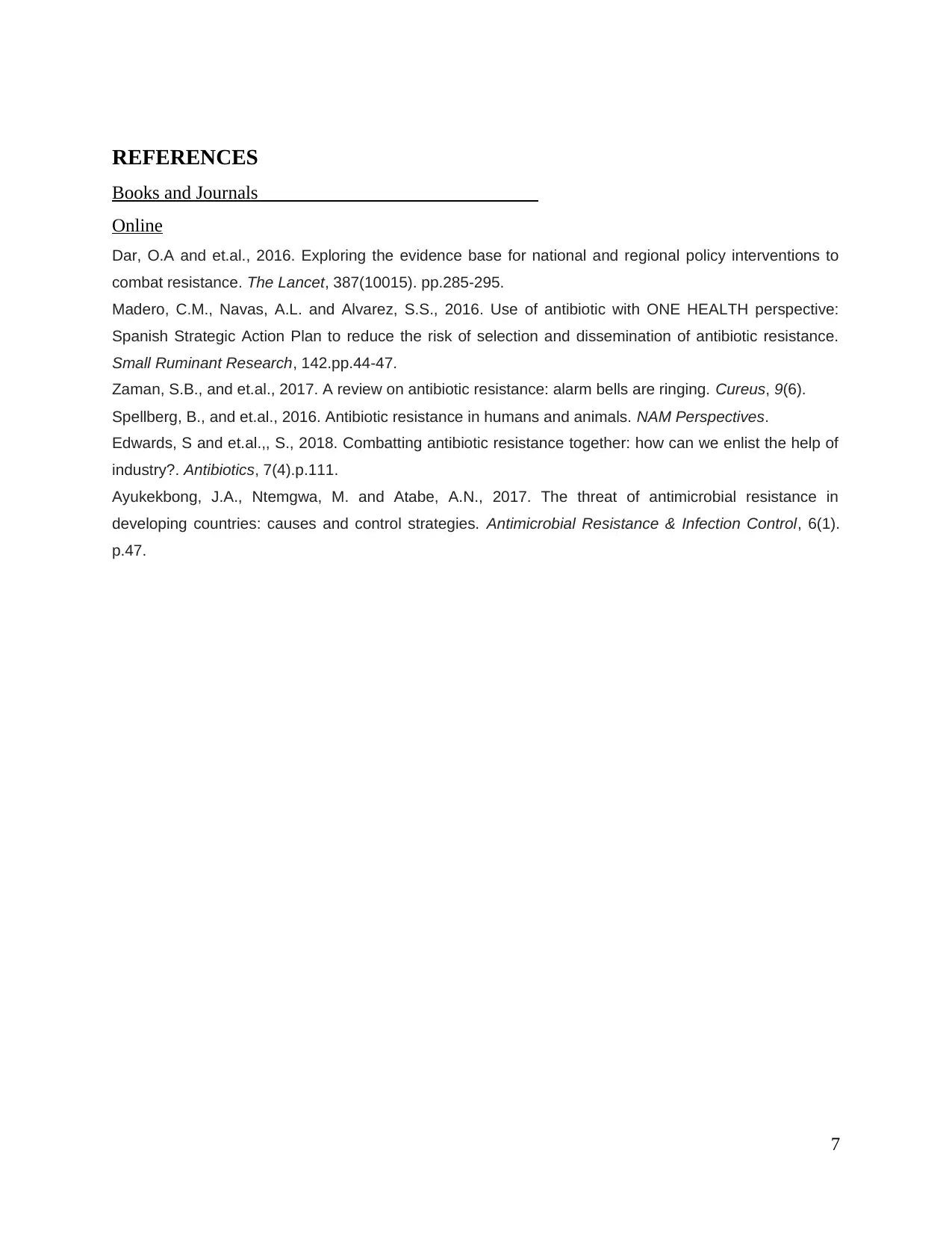
REFERENCES
Books and Journals
Online
Dar, O.A and et.al., 2016. Exploring the evidence base for national and regional policy interventions to
combat resistance. The Lancet, 387(10015). pp.285-295.
Madero, C.M., Navas, A.L. and Alvarez, S.S., 2016. Use of antibiotic with ONE HEALTH perspective:
Spanish Strategic Action Plan to reduce the risk of selection and dissemination of antibiotic resistance.
Small Ruminant Research, 142.pp.44-47.
Zaman, S.B., and et.al., 2017. A review on antibiotic resistance: alarm bells are ringing. Cureus, 9(6).
Spellberg, B., and et.al., 2016. Antibiotic resistance in humans and animals. NAM Perspectives.
Edwards, S and et.al.,, S., 2018. Combatting antibiotic resistance together: how can we enlist the help of
industry?. Antibiotics, 7(4).p.111.
Ayukekbong, J.A., Ntemgwa, M. and Atabe, A.N., 2017. The threat of antimicrobial resistance in
developing countries: causes and control strategies. Antimicrobial Resistance & Infection Control, 6(1).
p.47.
7
Books and Journals
Online
Dar, O.A and et.al., 2016. Exploring the evidence base for national and regional policy interventions to
combat resistance. The Lancet, 387(10015). pp.285-295.
Madero, C.M., Navas, A.L. and Alvarez, S.S., 2016. Use of antibiotic with ONE HEALTH perspective:
Spanish Strategic Action Plan to reduce the risk of selection and dissemination of antibiotic resistance.
Small Ruminant Research, 142.pp.44-47.
Zaman, S.B., and et.al., 2017. A review on antibiotic resistance: alarm bells are ringing. Cureus, 9(6).
Spellberg, B., and et.al., 2016. Antibiotic resistance in humans and animals. NAM Perspectives.
Edwards, S and et.al.,, S., 2018. Combatting antibiotic resistance together: how can we enlist the help of
industry?. Antibiotics, 7(4).p.111.
Ayukekbong, J.A., Ntemgwa, M. and Atabe, A.N., 2017. The threat of antimicrobial resistance in
developing countries: causes and control strategies. Antimicrobial Resistance & Infection Control, 6(1).
p.47.
7
Paraphrase This Document
Need a fresh take? Get an instant paraphrase of this document with our AI Paraphraser

8

9
⊘ This is a preview!⊘
Do you want full access?
Subscribe today to unlock all pages.

Trusted by 1+ million students worldwide
1 out of 9
Related Documents
Your All-in-One AI-Powered Toolkit for Academic Success.
+13062052269
info@desklib.com
Available 24*7 on WhatsApp / Email
![[object Object]](/_next/static/media/star-bottom.7253800d.svg)
Unlock your academic potential
Copyright © 2020–2025 A2Z Services. All Rights Reserved. Developed and managed by ZUCOL.




